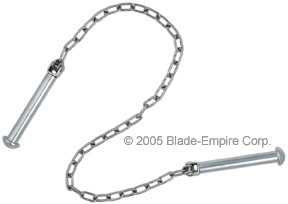|
Manriki is a throwing chain. When used with a whipping motion of the
wrist, it can injure or knock out opponents at a considerable distance.
Often at one end of the chain it had a round weight for extra punch or a
pointed weight (like an arrowhead).
People studying ninjutsu train using a cord with a knot
on the end. Even without it being metal, it can be surprisingly
effective.
The manriki gusari is a chain weighted at both ends. It
was developed as a self-defense weapon but was also a wicked offensive
weapon. It is small and easily concealed in the palm of the hand or in a
sash. While holding one end of the chain, it can be swung around and
used as a whip. The weighted end can cause a great deal of damage.
Masaki Ryu is one of Japan's older and more obscure
martial arts. Masaki Toshimitsu Dannoshin was a guard at a Buddhist
temple gate in Edo in the 1600's. He created the manriki-gusari so he
could do his job and not break the Buddhist prohibition against spilling
blood. He also developed the techniques for it's use and founded the
school that teaches these techniques and bears his name.
A manriki-gusari can range from three to twelve feet
long, with the average about six feet. The chain itself is called kusari
and the weights are called fundo. Students of Masaki Ryu will use the
manriki-gusari to entangle an opponent's weapon or limb, and then apply
a lock or choke with the other end of the chain. Sometimes the
manriki-gusari will be used to entangle and sweep the opponent's legs.
With the manriki-gusari possessing the two qualities of adding to a
martial artist's reach and being very concealable, it can be a
devastating weapon in the right hands.
Training in Masaki Ryu can be obtained only in Japan.
Even there it is not a popular and widely practiced art.
36" long overall. Rod measure 4 7/8" each. Available in either
black or
chrome. Also available as
regular Manriki chain. |
